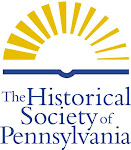November 13, 2009
Please join us at Fondly, Pennsylvania
While our work on the Chew project has been completed for some time now, we at HSP continue to work hard on many other archives and conservation projects to make our collections accessible and available to the public.
You can read more about our work on collections like the Friends of the Benjamin Franklin House, the Allen Family Papers, A.A. Humphreys, George Meade, and many others at our new blog Fondly, Pennsylvania: Notes from Archives and Conservation. Please join us!
You can read more about our work on collections like the Friends of the Benjamin Franklin House, the Allen Family Papers, A.A. Humphreys, George Meade, and many others at our new blog Fondly, Pennsylvania: Notes from Archives and Conservation. Please join us!
September 25, 2009
A Chew Celebration
Please Join Us for "A Chew Celebration" at the Historical Society of Pennsylvania, 1300 Locust Street, Philadelphia, PA 19107.
Join HSP as we celebrate the completion of the Chew Family Papers project, a two-year project to process and preserve one of the society’s most significant collections. The papers span 300 years and provide a rare insight into this elite Philadelphia family as well as into the lives of workers, slaves, servants, and women from early America. This project was made possible through a grant from the National Endowment for the Humanities and individual donations. Project Archivist Cathleen Miller will discuss the highlights of the collection and original documents will be on display. Refreshments will be served. FREE
To register for this event, please visit the Historical Society of Pennsylvania's website http://www.hsp.org/default.aspx?id=10.
July 31, 2009
The Long-Awaited Finding Aid
Today is the last day of the Chew processing project, and I am proud to announce that the finding aid is now live and available on the Historical Society of Pennsylvania's website for your reading pleasure.
Finding Aids: (Scroll down to "C"), and there you will find the xml and pdf versions. The xml file does not include the inventories, but it is all there in the pdf files. Total page count: 650.
http://www.hsp.org/default.aspx?id=35
July 30, 2009
Pennsylvania Lands: A guest post by project intern Dean Williams
Likely obvious to anyone who has read previous entries to this blog, the Chew Family Papers contain a great deal of information about the family’s land holdings. Primarily through the speculative efforts of Benjamin Chew and his son Benjamin Jr., the Chews owned thousands of acres of land throughout Pennsylvania, as well as substantial tracts in Delaware, Maryland, and New Jersey. Their land acquisition, spread out over the course of nearly a century, created a huge volume of paperwork. Many months of this project were spent sorting through and organizing the land papers. Within the collection, five series, containing approximately 30 linear feet of maps, surveys, and manuscript material, are devoted exclusively to land matters. As we come to the conclusion of this project, it seems appropriate to “speculate” on the various ways in which papers from these land series might be used.
The first use that comes to mind, and probably the one that is most self-evident, is how the Chew family itself affected, and was affected by, their extensive land holdings. In this regard, perhaps the most striking impressions one obtains from the land series documents is a sense of the family’s increasing financial difficulties over time. The question might be asked; “Did the ownership of such a large landed estate serve them well, or was it in some sense a hindrance?” While their properties made up a sizeable portion of the family estate, as their financial fortunes dwindled, one can note the increasing urgency in correspondence about the need to find buyers willing to pay the asking price. The family’s pecuniary needs, combined with the ever-increasing cost of maintaining their lands, in the form of taxes and other administrative costs, contributed to a financial squeeze. By the mid-nineteenth century, family members in charge of administering the land were emphatic with their agents about the need to sell the land. Turning to the question of what effect the Chew’s ownership had on the land itself, one might look to the papers for evidence on land settlement and development. A study of this type could also be extended to examine how late eighteenth-century land speculation played out over time, at least for one family. In this scenario, documents within the collection could be mined to help make a case for whether the family’s extended tenure over such large tracts of land had positive or negative repercussions.

Additionally, the land papers also provide numerous insights into family dynamics, such as the discrepancy between Benjamin III and his siblings over the settling of their father’s estate or the relationship between Henry B. Chew and his son Benjamin. Thus, the land papers might be used to supplement other information in the collection concerning inter-family relations. For example, papers from the land series help to complete the picture of how Benjamin III was replaced as chief executor by his brothers, Henry B. and William White, in addition to James M. Mason. In the case of the relationship between Henry B. Chew and his son Benjamin, personal correspondence between father and son provide the image of a demanding taskmaster, never quite satisfied with Benjamin’s efforts or behavior.
One further use of the land papers as they relate directly to the Chews is the examination of their land speculation. Like most speculative ventures, Benjamin Chew and his son invested a great deal of money into purchasing property with the hopes of making still larger sums. Considering the context of the times, when a large part of the Pennsylvania lands were purchased in the 1790s, and the financial collapse that so many other land speculators of the times suffered, the land papers might be used to unearth how one family was not swallowed by the economic forces that bankrupted some and sent many others to jail.
Expanding the focus beyond simply the immediate family, the land papers also provide a great deal of insight into people the Chews had contact with. With this in mind, the manuscripts might be searched for evidence documenting how the family dealt with those they did business with. For instance, one might examine the relationships between a well-to-do land owning dynasty and the many agents who administered their lands over time. The documents also provide a fair amount of information about numerous major and minor players involved in land speculation over the course of nearly a century. Related to this, the plethora of surveys and lists of land owners and renters lend themselves to a study of the patterns of land ownership and land conveyance.
Brainstorming on a still broader scale, and going beyond the Chews, one could envision using the land papers from this collection to act as a case study for various elements of land owning--with subjects ranging from wider inquiries into land speculation, to generalized patterns of settlement and land use. Potentially fruitful topics of study that would benefit from an examination of these papers include the subjects of land use over time, spurs and detriments to backland migration during the nineteenth century, and localized settlement of particular counties. This last usage of the papers extends, in particular, to the settling of many counties in Western Pennsylvania that were formerly dubbed “Depreciation” or “Donation” lands. For those interested in how the land itself was changed over time, the papers include numerous references to clear-cutting tree growth, agricultural development, and mineral discoveries occurring on, or near, the Chew property holdings. Because there is also a great deal of documentation concerning the difficulty of resolving and obtaining clear land title, these circumstances suggest an evaluation of land transference procedures. As a further possible use, the extensive account records available with the collection could be used for quantitative studies of land prices and rents over time.
These are just a few of the myriad of possible uses of the land papers within the Chew Family Papers.
The first use that comes to mind, and probably the one that is most self-evident, is how the Chew family itself affected, and was affected by, their extensive land holdings. In this regard, perhaps the most striking impressions one obtains from the land series documents is a sense of the family’s increasing financial difficulties over time. The question might be asked; “Did the ownership of such a large landed estate serve them well, or was it in some sense a hindrance?” While their properties made up a sizeable portion of the family estate, as their financial fortunes dwindled, one can note the increasing urgency in correspondence about the need to find buyers willing to pay the asking price. The family’s pecuniary needs, combined with the ever-increasing cost of maintaining their lands, in the form of taxes and other administrative costs, contributed to a financial squeeze. By the mid-nineteenth century, family members in charge of administering the land were emphatic with their agents about the need to sell the land. Turning to the question of what effect the Chew’s ownership had on the land itself, one might look to the papers for evidence on land settlement and development. A study of this type could also be extended to examine how late eighteenth-century land speculation played out over time, at least for one family. In this scenario, documents within the collection could be mined to help make a case for whether the family’s extended tenure over such large tracts of land had positive or negative repercussions.

Additionally, the land papers also provide numerous insights into family dynamics, such as the discrepancy between Benjamin III and his siblings over the settling of their father’s estate or the relationship between Henry B. Chew and his son Benjamin. Thus, the land papers might be used to supplement other information in the collection concerning inter-family relations. For example, papers from the land series help to complete the picture of how Benjamin III was replaced as chief executor by his brothers, Henry B. and William White, in addition to James M. Mason. In the case of the relationship between Henry B. Chew and his son Benjamin, personal correspondence between father and son provide the image of a demanding taskmaster, never quite satisfied with Benjamin’s efforts or behavior.
One further use of the land papers as they relate directly to the Chews is the examination of their land speculation. Like most speculative ventures, Benjamin Chew and his son invested a great deal of money into purchasing property with the hopes of making still larger sums. Considering the context of the times, when a large part of the Pennsylvania lands were purchased in the 1790s, and the financial collapse that so many other land speculators of the times suffered, the land papers might be used to unearth how one family was not swallowed by the economic forces that bankrupted some and sent many others to jail.
Expanding the focus beyond simply the immediate family, the land papers also provide a great deal of insight into people the Chews had contact with. With this in mind, the manuscripts might be searched for evidence documenting how the family dealt with those they did business with. For instance, one might examine the relationships between a well-to-do land owning dynasty and the many agents who administered their lands over time. The documents also provide a fair amount of information about numerous major and minor players involved in land speculation over the course of nearly a century. Related to this, the plethora of surveys and lists of land owners and renters lend themselves to a study of the patterns of land ownership and land conveyance.
Brainstorming on a still broader scale, and going beyond the Chews, one could envision using the land papers from this collection to act as a case study for various elements of land owning--with subjects ranging from wider inquiries into land speculation, to generalized patterns of settlement and land use. Potentially fruitful topics of study that would benefit from an examination of these papers include the subjects of land use over time, spurs and detriments to backland migration during the nineteenth century, and localized settlement of particular counties. This last usage of the papers extends, in particular, to the settling of many counties in Western Pennsylvania that were formerly dubbed “Depreciation” or “Donation” lands. For those interested in how the land itself was changed over time, the papers include numerous references to clear-cutting tree growth, agricultural development, and mineral discoveries occurring on, or near, the Chew property holdings. Because there is also a great deal of documentation concerning the difficulty of resolving and obtaining clear land title, these circumstances suggest an evaluation of land transference procedures. As a further possible use, the extensive account records available with the collection could be used for quantitative studies of land prices and rents over time.
These are just a few of the myriad of possible uses of the land papers within the Chew Family Papers.
Labels:
land,
Pennsylvania,
settlement,
speculation
July 14, 2009
Coming to a Close
We have been hard at work here in the 4th floor processing room, tidying up our finding aid, working on EAD tagging, labeling boxes, and just generally tying up loose ends. There are just 13 work days left in the project, and we are simply thrilled that we have managed to make this formidable collection much more accessible to researchers.

one of the many surveys in the collection
Here is a sneak-peak at some of the subjects that this collection touches upon: agriculture, architecture, child-rearing, family relationships, city planning, colonial life and culture, the Revolutionary and Civil wars, slavery, economic development, industrialization, shipping, relations with the Delaware Indians, politics, international relations, diplomacy, legal history, real estate, health, early medical care, women's history, cartography, land speculation, class, and the history of Pennsylvania, Maryland, New Jersey, and Delaware.
These topics are only the beginning. The Chews were involved in nearly every major happening in Philadelphia, and kept the records of their activities for nearly 300 years. The finding aid should be available online in August.
I hope to complete some subject-specific posts in the next few weeks to help guide researchers in their search through our very-lengthy finding aid. Stay tuned.

one of the many surveys in the collection
Here is a sneak-peak at some of the subjects that this collection touches upon: agriculture, architecture, child-rearing, family relationships, city planning, colonial life and culture, the Revolutionary and Civil wars, slavery, economic development, industrialization, shipping, relations with the Delaware Indians, politics, international relations, diplomacy, legal history, real estate, health, early medical care, women's history, cartography, land speculation, class, and the history of Pennsylvania, Maryland, New Jersey, and Delaware.
These topics are only the beginning. The Chews were involved in nearly every major happening in Philadelphia, and kept the records of their activities for nearly 300 years. The finding aid should be available online in August.
I hope to complete some subject-specific posts in the next few weeks to help guide researchers in their search through our very-lengthy finding aid. Stay tuned.
Labels:
completion,
description,
finding aid,
processing
June 17, 2009
The Concept of Property
Since the completion of processing last week, I have had the chance to go back through previously processed series to tweak the finding aid description. This has also included the exciting task of numbering each folder, now that we are sure there are no more documents lurking around to be added.
I started looking at Series 3, Samuel Chew (1737-1809), beginning with his account records. Throughout those files, I found many receipts that mentioned slaves from his plantations in Maryland. He owned five plantations, from all the accounts I have seen: Frisby's Meadows, the Great Plantation, Rich Neck, Swan Point, and Veazey Farm. All of them seem to have been located in Cecil County, Maryland, and there appear to have been 100+ slaves who lived on these farms. In the account records, there are bills from doctors who attended to "the people," as they are often called in the papers. There are many mentions of midwives, and lists of various medical treatments provided (usually the Latin names for herbs and compounds made into tinctures, pastes, and other preparations).
Some of the most detailed records about the enslaved people on Samuel Chew's farms are from the inventories of his estate after his death in 1809. Every time I look at these kinds of records, I am struck by the fact that people's lives were given monetary value, based on their age, their physical ability, and other factors. There is something about seeing these lists of property that really drives home the view of slaveholders, making it clear how they could continue to own other human lives and profit from their trade.
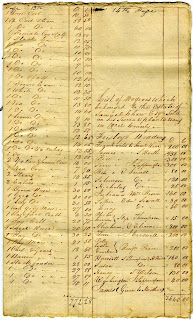

These pages are from an inventory registered in 1812. It lists all of the slaves who belonged to Samuel Chew's estate. They are listed by name, with the name of the person to whom they were sold and the price for which they were purchased.
These inventories provide extensive details about how the Chews lived. For instance, in one inventory, the total value of the estate is listed as $42800.10, which in today's dollars would be over 3/4 of a million dollars. There are lines in these inventories that detail all types of property, including meat, sugar, fabric, and other common items.
In the inventory below, Benjamin Chew Jr., who serves as the executor of Samuel's estate, lists "Eight single rose blankets, which as the black people on the Farms in Cecil were in want of bed clothing have been delivered unto those who needed it. (value: $16.00)"; and later, "1460 lbs. Bacon Sent from Chester Town to the Farms in Cecil where the black people were out of meat except what was reserved for the use of the family remaining at Chester Town + Except 25 hams sent to the residuary legatees in Philadelphia. (value: $183.50)
On the second page shown here, Benjamin describes some of the slaves: "For the Negro man named Dick, who being very sickly has been permitted under the discretion given to the Executor in the Will, to go at large, hiring himself when he is able to work & liable to be maintained out of the Estate when he shall be too infirm to take care of himself appraised at $75.00." The next entry is even more wrenching: "For a child Called Harriett who died $5 a grey horse that died early in Summer 70$"
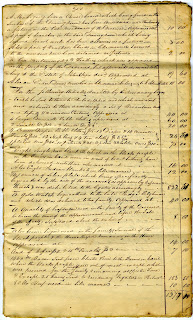

This collection is full of documents like these, and I imagine that these documents could open up a lot of doors for African-American genealogists, as well as scholars who are interested in the history of slavery in the Mid-Atlantic region.
I started looking at Series 3, Samuel Chew (1737-1809), beginning with his account records. Throughout those files, I found many receipts that mentioned slaves from his plantations in Maryland. He owned five plantations, from all the accounts I have seen: Frisby's Meadows, the Great Plantation, Rich Neck, Swan Point, and Veazey Farm. All of them seem to have been located in Cecil County, Maryland, and there appear to have been 100+ slaves who lived on these farms. In the account records, there are bills from doctors who attended to "the people," as they are often called in the papers. There are many mentions of midwives, and lists of various medical treatments provided (usually the Latin names for herbs and compounds made into tinctures, pastes, and other preparations).
Some of the most detailed records about the enslaved people on Samuel Chew's farms are from the inventories of his estate after his death in 1809. Every time I look at these kinds of records, I am struck by the fact that people's lives were given monetary value, based on their age, their physical ability, and other factors. There is something about seeing these lists of property that really drives home the view of slaveholders, making it clear how they could continue to own other human lives and profit from their trade.


These pages are from an inventory registered in 1812. It lists all of the slaves who belonged to Samuel Chew's estate. They are listed by name, with the name of the person to whom they were sold and the price for which they were purchased.
These inventories provide extensive details about how the Chews lived. For instance, in one inventory, the total value of the estate is listed as $42800.10, which in today's dollars would be over 3/4 of a million dollars. There are lines in these inventories that detail all types of property, including meat, sugar, fabric, and other common items.
In the inventory below, Benjamin Chew Jr., who serves as the executor of Samuel's estate, lists "Eight single rose blankets, which as the black people on the Farms in Cecil were in want of bed clothing have been delivered unto those who needed it. (value: $16.00)"; and later, "1460 lbs. Bacon Sent from Chester Town to the Farms in Cecil where the black people were out of meat except what was reserved for the use of the family remaining at Chester Town + Except 25 hams sent to the residuary legatees in Philadelphia. (value: $183.50)
On the second page shown here, Benjamin describes some of the slaves: "For the Negro man named Dick, who being very sickly has been permitted under the discretion given to the Executor in the Will, to go at large, hiring himself when he is able to work & liable to be maintained out of the Estate when he shall be too infirm to take care of himself appraised at $75.00." The next entry is even more wrenching: "For a child Called Harriett who died $5 a grey horse that died early in Summer 70$"


This collection is full of documents like these, and I imagine that these documents could open up a lot of doors for African-American genealogists, as well as scholars who are interested in the history of slavery in the Mid-Atlantic region.
Labels:
estate,
farming,
Frisby family,
plantations,
Samuel Chew,
slavery
June 11, 2009
Milestones
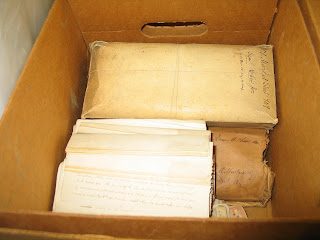
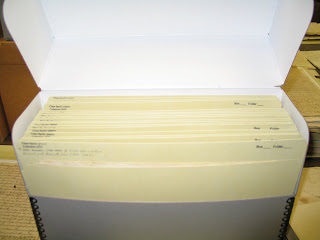
We have gone from this..............................................to This!
I never thought I would be able to say this, but today, we are done with processing! Every document has a home in a neatly-labeled folder--all the horror of the unexpected 50 linear feet of material in the stacks has abated, and now we get down to the nitty-gritty work of polishing our finding aid, numbering all the folders, making labels, marking up the finding aid, creating catalog records, writing our reports to NEH, and cleaning up data. Of course, there is still much to be done, but today feels like a very good day.
Leah and Jessica rolled up the last of the oversize maps today, and now there are a few lingering oversize folders to deal with, but all of this feels so much more manageable. I am buoyed by these accomplishments, and feel readier than ever to face the last month and a half of the project with energy and a clear head.
Just wanted to share this day with you all!
(Even the water leaking from the ceiling can't upset me today!)
Subscribe to:
Posts (Atom)
